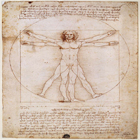OUR DESIGN PHILOSOPHY

The Vitruvian Man is a world-renowned drawing created by Leonardo da Vinci circa 1487. It is accompanied by notes based on the work of the famed architect, Marcus Vitruvius. The drawing, which is in pen and ink on paper, depicts a male figure in two superimposed positions with his arms and legs apart and simultaneously inscribed in a circle and square. The drawing and text are sometimes called the Canon of Proportions or, less often, Proportions of Man. It is stored in Gallerie dell'Accademia in Venice, Italy, and, like most works on paper, is displayed only occasionally.
The drawing is based on the correlations of ideal human proportions with geometry described by the ancient Roman architect Vitruvius in Book III of his treatise De Architectura. Vitruvius described the human figure as being the principal source of proportion among the Classical orders of architecture. Leonardo's drawing is traditionally named in honor of the architect.
The concept of Vitruvian Man:
… in the members of a temple there ought to be the greatest harmony in the symmetrical relations of the different parts to the general magnitude of the whole. Then again, in the human body the central point is naturally the navel. For if a man can be placed flat on his back, with his hands and feet extended, and a pair of compasses centered at his navel, the fingers and toes of his two hands and feet will touch the circumference of a circle described therefrom. And just as the human body yields a circular outline, so too a square figure may be found from it. For if we measure the distance from the soles of the feet to the top of the head, and then apply that measure to the outstretched arms, the breadth will be found to be the same as the height, as in the case of plane surfaces which are completely square.
(Marcus Vitruvius, De Architectura)
Our design philosophy follows similar principles as this theory. The ultimate goal in design is to combine individual elements into one harmonious piece. This involves taking various elements and providing proper balance, adding selective emphasis to create a focal point, using rhythm to set the mood and establishing unity.
"Good communication is as stimulating as black coffee... And just as hard to sleep after. " - Anne Morrow Lindbergh
